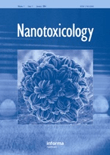
Nanotoxicology
Scope & Guideline
Unveiling the Impact of Nanotechnology on Life
Introduction
Aims and Scopes
- Assessment of Nanoparticle Toxicity:
Research in this area evaluates the toxic effects of various nanoparticles on biological systems, including cellular responses, organ-specific effects, and long-term health implications. - Mechanistic Studies of Nanotoxicity:
This focus involves investigating the underlying biological mechanisms through which nanoparticles exert toxic effects, including oxidative stress, inflammation, and genotoxicity. - Environmental Impact of Nanomaterials:
Studies assess the environmental fate and effects of nanoparticles, including their interactions with ecosystems and potential risks to wildlife and human health. - Biocompatibility and Biomedical Applications:
Research explores the use of nanoparticles in medical applications, such as drug delivery and imaging, while assessing their biocompatibility and associated risks. - Regulatory and Risk Assessment Frameworks:
This area focuses on developing guidelines and methodologies for the safe use of nanomaterials, including risk assessment protocols and regulatory implications. - Innovative Detection and Characterization Techniques:
Studies highlight new methods for detecting and characterizing nanoparticles in biological and environmental samples, enhancing understanding of their behavior and effects.
Trending and Emerging
- Machine Learning and Data-Driven Approaches:
The integration of machine learning techniques to predict nanoparticle toxicity and optimize risk assessments is gaining traction, indicating a trend towards computational toxicology. - Focus on Nanoplastics:
Research on the toxicity and environmental impact of nanoplastics is emerging as a significant theme, reflecting growing concerns about plastic pollution and its implications for health and ecosystems. - Sex-Based Differences in Toxicity:
An increased emphasis on understanding how biological sex influences the toxicological responses to nanoparticles is becoming apparent, highlighting the importance of personalized approaches in toxicology. - Multi-Organ and Systemic Toxicity Studies:
There is a trend towards investigating the systemic effects of nanoparticles across multiple organ systems rather than isolated studies, acknowledging the complex interplay of biological responses. - Innovative Nanomaterial Formulations:
Research is increasingly focusing on the development of novel nanomaterial formulations that aim to enhance therapeutic effects while minimizing toxicity, particularly in biomedical applications.
Declining or Waning
- Traditional Toxicology Approaches:
Research employing conventional toxicological methods with minimal adaptation to nanomaterials is becoming less frequent, as the field increasingly demands specialized nano-specific methodologies. - Generalized Nanoparticle Characterization:
There is a noticeable decline in studies that focus solely on basic characterization of nanoparticles without linking these findings to biological effects or environmental impact. - Single-Endpoint Toxicity Assessments:
Publications focusing on single endpoints of toxicity, such as cytotoxicity alone, are decreasing, with a shift towards more comprehensive assessments that consider multiple biological pathways and effects.
Similar Journals

TOXICOLOGY
Fostering dialogue and innovation in toxicological research.TOXICOLOGY, published by Elsevier Ireland Ltd, is a prestigious peer-reviewed journal specializing in the field of toxicology. With an ISSN of 0300-483X and an E-ISSN of 1879-3185, this journal provides a vital platform for researchers, professionals, and students to disseminate and access groundbreaking studies from 1973 to present, with a convergence set until 2024. Recognized for its high impact, it holds a Q1 ranking in Toxicology category and ranks #18 out of 133 in Scopus's sector of Pharmacology, Toxicology, and Pharmaceutics, placing it in the 86th percentile. While the journal is not open access, it nonetheless offers a rich collection of research articles that enhance the understanding of toxicological science and its applications. The journal's objectives encompass advancing knowledge in the toxicological evaluation of substances, promoting safety in public health, and fostering dialogue among scholars. As a key resource in the field, TOXICOLOGY plays a crucial role in advancing research and informing practices related to toxicological risks and safety assessments.
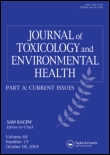
JOURNAL OF TOXICOLOGY AND ENVIRONMENTAL HEALTH-PART A-CURRENT ISSUES
Illuminating Critical Issues in Environmental ToxicologyJOURNAL OF TOXICOLOGY AND ENVIRONMENTAL HEALTH-PART A-CURRENT ISSUES, published by Taylor & Francis Inc, stands as a key resource in the interdisciplinary field of toxicology and environmental health. Operating under the ISSN 1528-7394 and E-ISSN 1087-2620, this journal maintains a strong presence with a Q2 category ranking in Health, Toxicology and Mutagenesis and a Q3 ranking in Toxicology as of 2023. It aims to disseminate critical findings that address contemporary issues in toxicology and environmental health, emphasizing the implications of environmental agents on human health. The journal offers both subscription and open access options, making cutting-edge research accessible to a diverse readership. With coverage of key topics from 1998 to 2024, it is an essential platform for academics, professionals, and students seeking to stay at the forefront of environmental health sciences.

Digest Journal of Nanomaterials and Biostructures
Unveiling Breakthroughs in Nanotechnology and Material ScienceThe Digest Journal of Nanomaterials and Biostructures, published by VIRTUAL CO PHYSICS SRL, is a premier open-access journal since 2006, focusing on the dynamic intersections of nanotechnology, biostructures, and material science. Based in Romania, this journal caters to a diverse readership of researchers, professionals, and students in fields such as nanoscience, biomedical engineering, and condensed matter physics. Despite its current Q4 ranking in multiple categories, including Atomic and Molecular Physics and Structural Biology, the journal serves as a valuable platform for disseminating innovative research and fostering collaboration across scientific disciplines. The journal’s commitment to open access ensures that groundbreaking findings in nanomaterials are readily available to a global audience, reflecting the increasing importance of interdisciplinary research in addressing contemporary challenges. With its ongoing evolution and the potential for high-impact contributions to the scientific community, Digest Journal of Nanomaterials and Biostructures plays a crucial role in advancing knowledge and innovation in its respective fields.

ARCHIVES OF TOXICOLOGY
Advancing the Frontiers of Toxicological ScienceARCHIVES OF TOXICOLOGY is a prestigious journal published by Springer Heidelberg, dedicated to advancing research in the field of toxicology and related disciplines. With a distinguished history dating back to 1930, this journal has continuously provided vital insights and groundbreaking studies, making it a cornerstone in the areas of health, toxicology, and medicine. Recognized for its high impact, it occupies a top-ranking position in Scopus, with remarkable quartile placements in 2023, categorizing it as Q1 in Health, Toxicology and Mutagenesis, and Q1 in Medicine (Miscellaneous). The journal highlights critical research and innovative methodologies, appealing to a diverse audience of researchers, professionals, and students committed to understanding the complexities of toxic substances and their implications for public health and environmental safety. The journal does not currently offer open access, allowing for a more traditional but rigorous peer-review process that ensures the quality and integrity of every published article. Join the global discourse in toxicological science with ARCHIVES OF TOXICOLOGY, where every contribution furthers the understanding of safety and toxicity in our world.
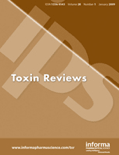
Toxin Reviews
Empowering Science Through Open Access ResearchToxin Reviews is a premier academic journal focused on the critical field of Toxicology, published by Taylor & Francis Inc. Established with an aim to foster research and disseminate knowledge, this journal has been pivotal since its inception in 1982 and continues to be a leading platform for both emerging and established researchers. With an impressive impact factor and ranked in the 75th percentile among its peers in the Scopus categories, it serves as an essential resource for scientists, practitioners, and students interested in understanding the complexities of toxins and their effects on health. The journal provides an Open Access platform, enhancing visibility and accessibility of research findings to a broader audience. Covering a wide scope, Toxin Reviews plays a vital role in bridging gaps between toxicological research and practical applications, ensuring that rigorous scientific inquiry translates into real-world solutions.
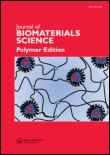
JOURNAL OF BIOMATERIALS SCIENCE-POLYMER EDITION
Bridging science and application in polymer biomaterials.JOURNAL OF BIOMATERIALS SCIENCE-POLYMER EDITION, published by Taylor & Francis Ltd, is a distinguished scholarly journal dedicated to the exploration of biomaterials and their applications in various fields such as bioengineering, biomedical engineering, and biophysics. With an ISSN of 0920-5063 and an E-ISSN of 1568-5624, this journal offers a platform for researchers and professionals to share innovative findings and methodologies that advance the science of polymer-based biomaterials. The journal's impact within the academic community is underscored by its notable Scopus rankings, including a Q2 status in both Biomedical Engineering and Biophysics as of 2023, reflecting its significant contribution to advancing knowledge and practice in these fields. The scope of the journal spans from fundamental research to applications in medical devices and regenerative medicine, ensuring comprehensive coverage of the latest trends and breakthroughs. Although it does not currently offer open access options, the journal remains a pivotal resource for students, researchers, and professionals committed to the development and application of biomaterials in healthcare. For further details, the journal is based in Abingdon, United Kingdom, at 2-4 Park Square, Milton Park, OX14 4RN.

Nanobiotechnology Reports
Connecting researchers to the pulse of nanobiotech advancements.Nanobiotechnology Reports, an impactful journal published by PLEIADES PUBLISHING INC, serves as a prominent platform for disseminating cutting-edge research at the intersection of nanotechnology and biotechnology. With its ISSN 2635-1676 and E-ISSN 2635-1684, this open-access journal is committed to providing researchers, professionals, and students with accessible knowledge and innovations that drive advancements in this rapidly evolving field. Operating out of the United States, Nanobiotechnology Reports has established itself in various engineering and science categories, including Bioengineering and Biomedical Engineering, currently holding a Q4 quartile ranking in 2023. Although it is in the early stages of its publication journey since its convergence in 2021, the journal aims to foster collaboration and knowledge-sharing within the scientific community, addressing the complexities of nanomaterials and their applications in biological systems. Researchers and practitioners in nanobiotechnology are encouraged to contribute to this expanding body of knowledge, facilitating the development of innovative solutions that impact various sectors, from healthcare to electronics.
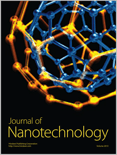
Journal of Nanotechnology
Empowering Researchers with Open Access Nanotech FindingsThe Journal of Nanotechnology, published by Hindawi Ltd., is a premier open-access platform dedicated to delivering high-quality research in the dynamic field of nanotechnology. With the ISSN 1687-9503 and E-ISSN 1687-9511, this journal has been at the forefront of disseminating innovative findings since its transition to open access in 2009, fostering a global dialogue among researchers, professionals, and students. Based in Egypt, the journal maintains its commitment to advancing the material science sector, currently holding a prestigious Q2 ranking in the 2023 Materials Science (miscellaneous) category, reflecting its significant contribution to the field. With a Scopus ranking of #162 out of 463 journals in General Materials Science, placing it in the 65th percentile, the Journal of Nanotechnology serves as a crucial resource for those looking to explore the latest advancements and applications in nanomaterials. The journal invites submissions that align with its scope, which emphasizes interdisciplinary approaches and novel methodologies, promising to enhance both academic and practical aspects of nanotechnology.

Cancer Nanotechnology
Advancing Cancer Research through Nanotechnology InnovationCancer Nanotechnology is a cutting-edge peer-reviewed journal dedicated to advancing the field of cancer research through innovative nanotechnology applications. Published by SPRINGER WIEN, this open-access journal, established in 2010, provides a vital platform for the dissemination of high-quality research with a focus on the intersection of nanotechnology, oncology, and biomedical engineering. With a commitment to promoting accessibility and fostering collaboration, Cancer Nanotechnology has gained impressive rankings within specialized categories, including Q2 in Biomedical Engineering and Pharmaceutical Science. The journal's rigorous selection process ensures that only the most impactful studies reach its audience, making it a must-read for researchers, professionals, and students eager to explore the latest advancements and methodologies in cancer treatment. With its scope encompassing critical topics that bridge multiple disciplines—including physical chemistry and toxicology—Cancer Nanotechnology positions itself as an influential resource for shaping the future of cancer therapies.

Toxicological Research
Elevating toxicological research to new heights of understanding.Toxicological Research is a prominent academic journal dedicated to advancing the field of toxicology through rigorous exploration and innovative research. Published by the Korean Society of Toxicology, this journal serves as a vital resource for researchers, professionals, and students engaged in environmental science, pharmacology, and toxicology. With an ISSN of 1976-8257 and an E-ISSN of 2234-2753, Toxicological Research highlights significant findings and discussions in the realm of health, toxicology, and mutagenesis. Although not an open-access journal, it maintains a solid reputation as evidenced by its Q3 ranking in both health-related toxicology and general toxicology categories for 2023. The journal covers a broad spectrum of topics from fundamental research to applied toxicology and provides a unique platform for the dissemination of knowledge in a field that is increasingly relevant in today’s society. With an anticipated convergence period from 2008 to 2024, Toxicological Research continues to contribute vital insights to understanding the implications of toxic substances on health and the environment.